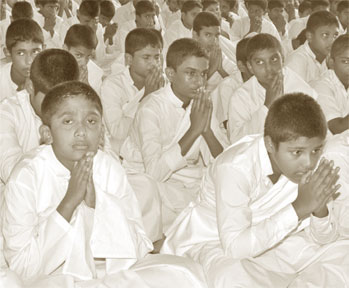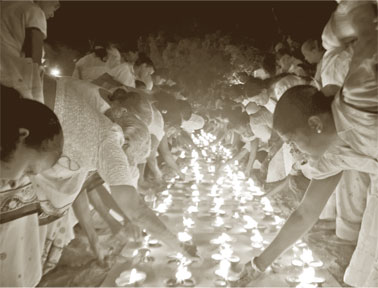|
 Duruthu Poya: Duruthu Poya:
Commemorates Buddha's first visit to Sri Lanka
By Ananda KANNANGARA
The Duruthu Full Moon Poya is observed on a grand scale by Buddhists
in Sri Lanka and all over the world as the first Poya in the calendar.
This Poya is important to Buddhists, especially Sri Lankan Buddhists,
due to many events which had occurred on this day in the history of Sri
Lanka's Buddhism.
Sakyamuni Gautama Buddha's first visit to Mahiyangana had taken place
on a Duruthu Full Moon Poya Day. The arrival of the Buddha in
Mahiyangana is an event of great historical importance, because this
sacred event had preceded the introduction of Buddhism to Sri Lanka by
Arahant Mahinda Thera.
Although Buddhists do not celebrate this Poya on the same scale as
Vesak, Poson and Esala Poyas, by conducting various festivities, temples
in villages conduct bodhi poojas, bana preachings, pahan poojas and sil
campaigns, considering its importance as the first poya in the new year.
Ancient chronicles reveal that the Buddha arrived at Mahiyangana, the
splendid park in the vicinity of the Mahaweli Ganga, to settle a dispute
of a Yakka tribe. The Yakkas behaved in a rough manner and opposed the
arrival of the Buddha. However, they were miraculously won over by the
Buddha who helped them to be good citizens.

|
Buddha at Mahiyangana
It was on a Duruthu Full
Moon Poya Day that the Buddha paid his first visit to Sri
Lanka, to Mahiyangana to overpower the Yakkas who had
assembled at the Mahanagavana Park by the Mahaweli River at
Mahiyangana-the site on which a great stupa now stands.
Having cleansed the land,
the Buddha preached the Dhamma to a great gathering of gods
and deities and in response to the request by God Sumana
Saman, who had attained the first stage of sothapanna on the
occasion, offered him a handful of His hair as an object to
worship before His departure for Uruvela on the same day. |
During this period, the inhabitants of this country were Yakkas, who
were humans and descendants of King Rawana and his brother, Vibhishana.
Descendants of the Naga tribe also lived here. It is said that Yakkas
and Nagas were in constant confrontation with each other.
The Mahiyangana Dagoba, which is also known as Miyuguna Seya, was
built at the site of the Mahanaga grove in Minipe where the Buddha had
subjugated the Yakkas.
One of the most significant aspects of the event was the presence of
Deva Mahasumana, the guardian god of Mount Samanala, popularly known as
Sri Pada. History reveals that Deva Mahasumana attained the State of
Sothapanna after listening to the sermon delivered by the Buddha at
Mahiyangana.
Diplomatic relations
According to the Mahavamsa, Deva Mahasumana begged the Thathagatha to
give something to remember His first visit to the island.
The Buddha gave him a handful of hair from His head which Mahasumana
placed in a golden casket and later enshrined in a Stupa embedded with
blue stones.
The Buddha's first visit to Sri Lanka also helped boost diplomatic
relations between Sri Lanka and India. The Mahawamsa speaks about three
visits made by the Buddha to Sri Lanka.
  The month of Duruthu is also significant for Buddhists due to a
number of other incidents. The Buddha put the arrogant Kassapa brothers
- Uruwel Kassapa, Gaya Kassapa and Nadi Kassapa - on the correct path on
this day. It is also during the month of Duruthu (January) that the
Duruthu Perahara of the Kelaniya Rajamaha Vihara is held. According to
ancient chronicles, the Buddha's second visit to Sri Lanka was to
Nagadeepa, to settle a dispute between an uncle and nephew, Chulodara
and Mahodara. They were at loggerheads over the ownership of a
gem-studded throne. The month of Duruthu is also significant for Buddhists due to a
number of other incidents. The Buddha put the arrogant Kassapa brothers
- Uruwel Kassapa, Gaya Kassapa and Nadi Kassapa - on the correct path on
this day. It is also during the month of Duruthu (January) that the
Duruthu Perahara of the Kelaniya Rajamaha Vihara is held. According to
ancient chronicles, the Buddha's second visit to Sri Lanka was to
Nagadeepa, to settle a dispute between an uncle and nephew, Chulodara
and Mahodara. They were at loggerheads over the ownership of a
gem-studded throne.
The raging King Mahodara was about to wage war, when the Buddha saw
it with His divine eyes. He appeared in Nagadeepa and settled the
dispute. The chronicles also reveal that the Northern area had been
ruled by several kings in Anuradhapura.
Neck relics
History also reveals that after the Parinibbana of the Buddha, some
neck relics (Greeva Dathu) of the Buddha was brought to Sri Lanka by
Arahant Sarabhu- a pupil of Arahant Sariputta and enshrined in the
Mahiyangana Dagoba, raising it to 12 riyan. It was later extended to a
height of 30 riyan by King Uddachulabhaya, the brother of King
Devanampiyatissa .
It was also during the month of Duruthu that the Omniscient One
proceeded to the Magadha Kingdom accompanied by Jatila Arahants.
The visit was made in keeping with an invitation extended by Magadha
King Bimbisara to the Buddha before His Enlightenment.
 Having seen the Buddha with Arahant Kassapa, King Bimbisara hesitated
to believe that Uruwel Kassapa had become a disciple of the Buddha. Having seen the Buddha with Arahant Kassapa, King Bimbisara hesitated
to believe that Uruwel Kassapa had become a disciple of the Buddha.
Realising the King's misconception, Arahant Uruwel Kassapa performed
a pelahara (miracle) to indicate that all the Jatila Arahants, including
himself, were now disciples of the Buddha. King Bimbisara and his people
were very happy and devotedly embraced Buddhism.
The Buddha preached the Dhamma and all of them took refuge in the
Triple Gem. King Bimbisara offered the Veluwanarama to the Buddha. He
then made a proclamation allowing Bhikkhus to accept monasteries when
offered by devotees.
King Bimbisara had dreamed that his deceased relatives were
suffering, having been born as goblins. The Buddha preached the Dhamma
to offer merit to those goblins on the Duruthu Full Moon Poya Day. |

